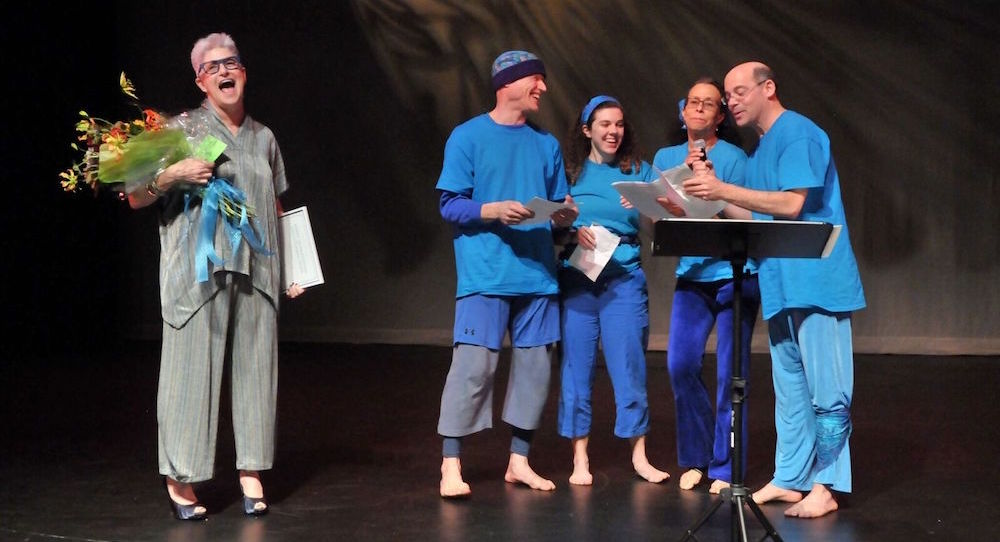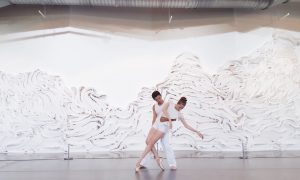Talking with Jeanne Traxler was like having a comfortable conversation with a longtime friend, only we’d never met and, instead of chatting over coffee, we were conferencing on the phone as a quick break in our days. This past April, Traxler was honored as the recipient of the 2018 Boston Dance Alliance (BDA) Dr. Michael Shannon Dance Champion Award at the BDA gala. Being honored in this way took Traxler from feeling a “little cynical at first; I’m not a big about awards”, to “incredibly moved, really grateful and incredibly humbled. My friends came out, the dancers sang a song, it was a fantastic evening, and I even had a great dress,” Traxler happily chuckles.
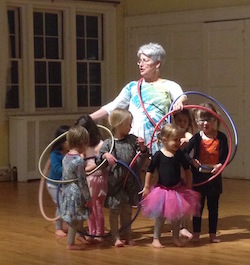
Jeanne Traxler with students. Photo courtesy of Traxler.
Traxler is the founder and director of the Brookline-based Peanut Butter & Jelly Dance Company that comprises a professional company, children’s dance classes and the “Small Feets” youth performance troupe, which has reached more than 70,000 students since 1980.
BDA Executive Director Debra Cash says, “Jeanne Traxler’s exuberance has transformed countless young dancers’ lives and introduced them to their own potential.” Dr. Michael Shannon, the namesake of the Dance Champion Award bearing his name, was a world-renowned pediatric toxicologist and former head of emergency medicine at Children’s Hospital in Boston. He was known as the “dancing doctor” for his exuberant interest and participation in the art form. He also served as President of the Boston Dance Alliance Board. When speaking with Traxler, it is apparent that her passion for teaching dance to children parallels Dr. Shannon’s commitment to being a medical advocate for children. Their professional passions manifested in different ways, but concern for the welfare of children and a love of movement are definitely shared qualities.
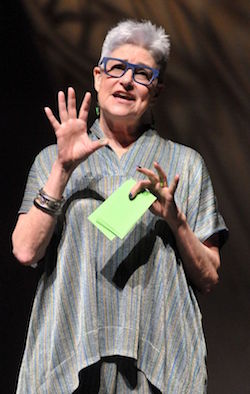
Jeanne Traxler. Photo by Craig Bailey/Perspective Photo
When asked for a single piece of advice, Traxler freely shares, “Put your kids into dance classes. Little kids love to dance. These preschools (where I teach) are regular preschools, and I teach every kid and every kid is excited when I come. They like the movement challenges, and they like the music. Put your child into something that you might not have any experience in. Put your boys in. I’ve been teaching since 1976. For some kids, it really resonates, and you don’t know without trying.”
And what makes dance so special? Traxler adds, “First, it’s physically engaging. Kids don’t get enough outdoor and movement time. Many people live in small spaces, so even if you do dance in your living room, there’s not much space. Children also spend a lot of time in scheduled activities, rather than activities that are free in movement. Kids also spend a lot of time in car seats and strollers, and they are very bound up a lot of the time and not having time to move their limbs. Creative movement is very open ended. It stimulates eye/hand coordination, and improvisation helps with problem-solving and learning how to work in small groups and follow directions. Dance has all the benefits of school. It’s about conceptualizing material and using things you know to produce art. Children take an idea and respond to it in an artful way. If you know something about the planets, you can do a dance about space. You can do a dance about dinosaurs because you know some things about dinosaurs. Kids can move toward dance in a basic way, and they can move to other levels and other kinds of things. Kids from our classes do not have bad habits, and they know how to move their whole body and to think in a ‘dancey’ way about dance things. They also know how to concentrate.” These skills, says Traxler, will help a child with any future endeavor.
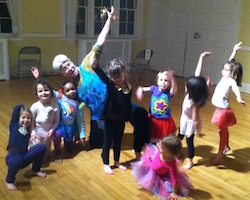
Jeanna Traxler and students make a group shape. Photo courtesy of Traxler.
It seems obvious that dance training, especially for the very young, is an asset. So, we ask Traxler why it’s not more common in the K-12 setting. She has a lot of balanced insights on the topic. “In some ways, it’s a bit of a self-perpetuating circle. You have adults who fill the school who are not comfortable dancing themselves. They did a little square dancing in gym. That’s not the same as being taught an art form by an artist teacher who loves them. There are very few of those people in principal and school board positions. The schools are strapped and already adding new programming. All schools have added technology teachers. Now if you say the schools need a dance teacher, they’ll say you have another head. You have a gym teacher and a music teacher you see once a week. You have no advocate (for dance). It can be great for the kids, and lots of kids do not want to be in sports. There can also be competition within the programs, so it’s analogous to sports in some ways.”
Trailer adds that dance in the schools would even be good for local studio owners. “You are always going to have kids who want to train more than one day a week at school, and those kids will fill the studios.”
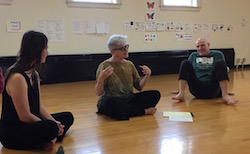
Jeanne Traxler teaching a workshop at University of Wisconsin at the 90th Anniversary of the Dance Department Celebration. Photo courtesy of Traxler.
There’s also the issue of money, adds Traxler. “Music has an industry that supports it. There’s sheet music, the uniform industry and the copyright industry. The art industry has people who make paper, paint and other supplies. Then there’s dance. You do it with your body, and you don’t even need an outfit. Because there’s not money in dance – no industry to support dance – it’s often taught by a gym teacher.”
So, what’s a parent wanting to enroll his or her child in dance to do? “I’m not going to nay say a school,” says Traxler. There are a lot of schools that offer training for kids. My personal philosophy is that taking ballet as a three-year-old is creative movement, no matter what you do. Go look. You have to go look. There can be an extremely creative teacher in a school of strictly ballet. That teacher can teach in an age-appropriate way. I think creative movement is one of the most appropriate ways to train young children, and it’s the way kids study other things, so it’s the way to study dance. It’s a sort of Montessori approach. But, if there’s no Montessori around, it’s not the only thing. If you can’t find a creative movement program, take a look at another program. There’s probably a teacher who is warm, kind and sweet. You wouldn’t move to an area without checking out the area, so go look. Go look and find a teacher. Dance has to be taught to you by a teacher. You cannot learn it on the internet. Find a good, kind teacher who is looking for you to be the best you can be. You do not need to be driven or beaten into dancing well. You are encouraged your desire is whet to the point that you cannot help but improve.”
For more information about Jeanne Traxler and Peanut Butter & Jelly Dance Company, visit pbjdanceco.org.
By Emily Yewell Volin of Dance Informa.


